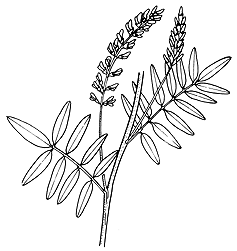
Description: Perennial glandular-hairy herbs or subshrubs.
Leaves imparipinnate; leaflets 5–17, rarely 3-foliolate, gland-dotted (often aromatic when crushed); stipules membranous, caducous; stipels absent.
Inflorescences axillary racemes, 10–60-flowered; bracts caducous; bracteoles absent. Calyx ± campanulate, with 5 ± equal teeth, upper 2 partially fused. Standard ovate to lanceolate or oblong; keel shorter, obtuse to ± acute. Stamens diadelphous; anthers alternately long and short. Ovary sessile, ovules 2–4; style incurved, glabrous; stigma oblique, terminal.
Pod terete or compressed, sometimes dehiscent; seeds without aril.
Distribution and occurrence: World: 18 species, cosmopolitan temperate & subtropical regions. Australia: 2 species (1 species endemic), Qld, N.S.W., Vic., S.A., W.A.
Text by C. Gardner
Taxon concept:
| | Key to the species | |
| 1 | Leaves usually less than 8 cm long; leaflets ± 8 mm wide; flowers 5–8 mm long; pod ovoid, 5–6 mm long, bristly, 1-seeded | Glycyrrhiza acanthocarpa |
| Leaves usually more than 8 cm long; leaflets 8–20 mm wide; flowers 10–13 mm long; pod linear-oblong, 10–20 mm long, glabrous, mostly 2–6-seeded | Glycyrrhiza glabra |
|


